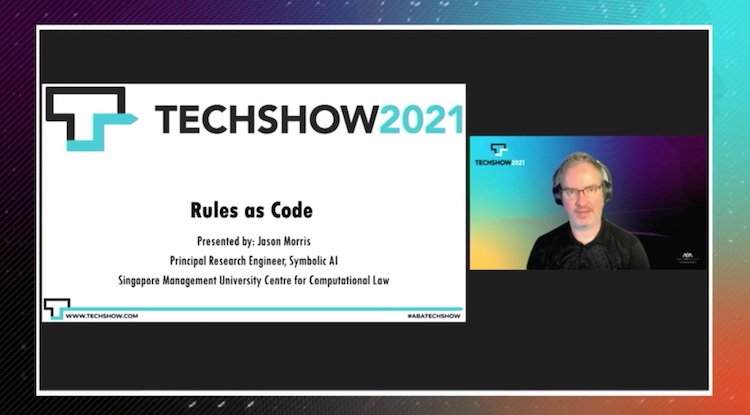Automated legal reasoning could shape future of digital services

Jason Morris of the Singapore Management University Centre for Computational Law speaks at the ABA Techshow 2021 on Thursday.
In the next 20 years, digital technology that automates legal reasoning will change how laws are written and could help widen access to justice, an expert predicted Thursday at ABA Techshow.
Jason Morris of the Singapore Management University Centre for Computational Law delved into the complex topic of coding legal rules and regulations for his panel: “Rules as Code: How Technology May Change the Language in which Legislation is Written, and What it Might Mean for Lawyers of Tomorrow.”
Morris defined “rules as code” as an “interdisciplinary legal drafting methodology” that involves co-drafting of written and computer languages and “automated testing that improves rules and simplifies automation.”
Before an app is coded, a client and drafter will typically draft written rules and hand them off to a programmer, Morris said. During coding, multiple programmers are involved in the creation of an app. That can lead to errors in the interpretation of the written rules, Morris explained.
Using the rules as code technique, a programmer could be added to the drafting of rules at the beginning of the process, with the client and drafter to ensure that the written rules and the encoded version match.
He said that France is a leader in using rules as code. The country has used the tools OpenFisca and LexImpact to test the impact of amendments to French tax law, Morris wrote in a paper posted before the panel.
Follow along with the ABA Journal’s coverage of the ABA Techshow 2021 here.
Applied generally, Morris posited in his paper that encoded rules could test whether a proposed tax law really had the effect of making sure people’s taxes didn’t go up by running large numbers of fact patterns and test scenarios, for instance.
“This task of coming up with situations in which the rule does not behave as expected is a major part of the expertise of legal drafting,” he wrote. “Legal professionals use their imagination and their experience to think of scenarios, and then mentally check whether those scenarios will behave as expected. Rules as code gives us the ability to get the help of computers with that process, supercharging that human ability.”
Morris also demonstrated rules as code with an open-source legal reasoning tool he has developed called Blawx. The digital tool allows lawyers to test laws, rules and contracts. He automated and tested the rules of the game rock-paper-scissors in Blawx to reveal who won a hypothetical matchup.
Morris said that rules as code have implications for the legal industry and that automated legal reasoning will “increase speed, quality and demand for legal services.”
“In the next 20 years, automated legal reasoning tools are going to become a basic competence of the legal profession, and the modeling language that they use is going to be a language, and eventually the language in which laws are written,” Morris predicted.
He said that automated services are important for providing services to increase access to justice “because we need a computer’s help.”
“When we’re regulating and thinking about how to treat these kinds of technologies, we need to take into consideration the fact that we don’t just have an ethical duty to protect confidentiality or an ethical duty to provide services competently. We also have an ethical duty to ensure that legal services are provided in an efficient and affordable way,” Morris said.



